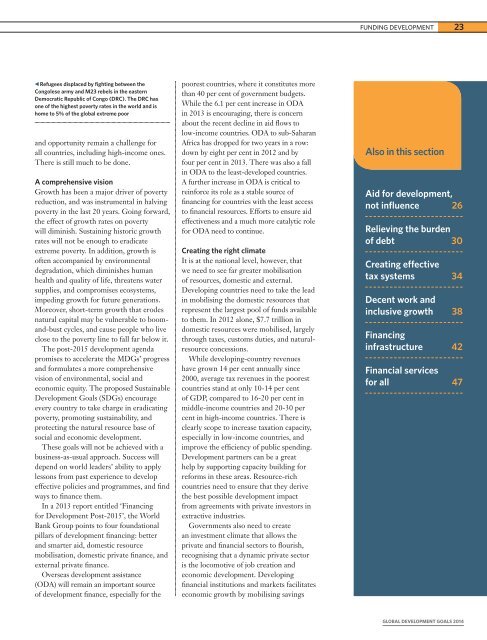FAMBB
FAMBB
FAMBB
You also want an ePaper? Increase the reach of your titles
YUMPU automatically turns print PDFs into web optimized ePapers that Google loves.
FUNDING DEVELOPMENT23Refugees displaced by fighting between theCongolese army and M23 rebels in the easternDemocratic Republic of Congo (DRC). The DRC hasone of the highest poverty rates in the world and ishome to 5% of the global extreme poorand opportunity remain a challenge forall countries, including high-income ones.There is still much to be done.A comprehensive visionGrowth has been a major driver of povertyreduction, and was instrumental in halvingpoverty in the last 20 years. Going forward,the effect of growth rates on povertywill diminish. Sustaining historic growthrates will not be enough to eradicateextreme poverty. In addition, growth isoften accompanied by environmentaldegradation, which diminishes humanhealth and quality of life, threatens watersupplies, and compromises ecosystems,impeding growth for future generations.Moreover, short-term growth that erodesnatural capital may be vulnerable to boomand-bustcycles, and cause people who liveclose to the poverty line to fall far below it.The post-2015 development agendapromises to accelerate the MDGs’ progressand formulates a more comprehensivevision of environmental, social andeconomic equity. The proposed SustainableDevelopment Goals (SDGs) encourageevery country to take charge in eradicatingpoverty, promoting sustainability, andprotecting the natural resource base ofsocial and economic development.These goals will not be achieved with abusiness-as-usual approach. Success willdepend on world leaders’ ability to applylessons from past experience to developeffective policies and programmes, and findways to finance them.In a 2013 report entitled ‘Financingfor Development Post-2015’, the WorldBank Group points to four foundationalpillars of development financing: betterand smarter aid, domestic resourcemobilisation, domestic private finance, andexternal private finance.Overseas development assistance(ODA) will remain an important sourceof development finance, especially for thepoorest countries, where it constitutes morethan 40 per cent of government budgets.While the 6.1 per cent increase in ODAin 2013 is encouraging, there is concernabout the recent decline in aid flows tolow-income countries. ODA to sub-SaharanAfrica has dropped for two years in a row:down by eight per cent in 2012 and byfour per cent in 2013. There was also a fallin ODA to the least-developed countries.A further increase in ODA is critical toreinforce its role as a stable source offinancing for countries with the least accessto financial resources. Efforts to ensure aideffectiveness and a much more catalytic rolefor ODA need to continue.Creating the right climateIt is at the national level, however, thatwe need to see far greater mobilisationof resources, domestic and external.Developing countries need to take the leadin mobilising the domestic resources thatrepresent the largest pool of funds availableto them. In 2012 alone, $7.7 trillion indomestic resources were mobilised, largelythrough taxes, customs duties, and naturalresourceconcessions.While developing-country revenueshave grown 14 per cent annually since2000, average tax revenues in the poorestcountries stand at only 10-14 per centof GDP, compared to 16-20 per cent inmiddle-income countries and 20-30 percent in high-income countries. There isclearly scope to increase taxation capacity,especially in low-income countries, andimprove the efficiency of public spending.Development partners can be a greathelp by supporting capacity building forreforms in these areas. Resource-richcountries need to ensure that they derivethe best possible development impactfrom agreements with private investors inextractive industries.Governments also need to createan investment climate that allows theprivate and financial sectors to flourish,recognising that a dynamic private sectoris the locomotive of job creation andeconomic development. Developingfinancial institutions and markets facilitateseconomic growth by mobilising savingsAlso in this sectionAid for development,not influence 26Relieving the burdenof debt 30Creating effectivetax systems 34Decent work andinclusive growth 38Financinginfrastructure 42Financial servicesfor all 47GLOBAL DEVELOPMENT GOALS 2014


